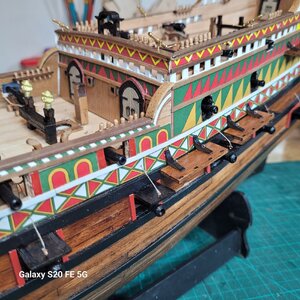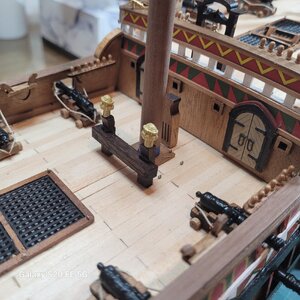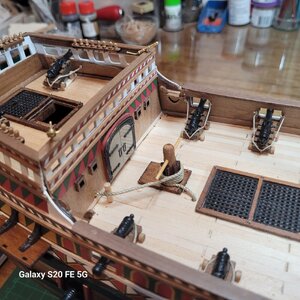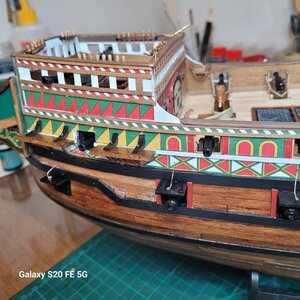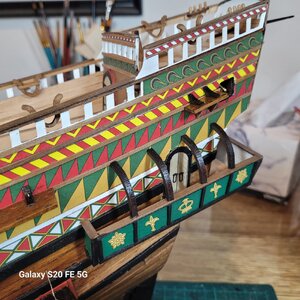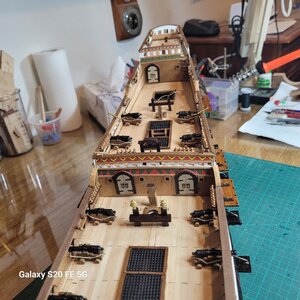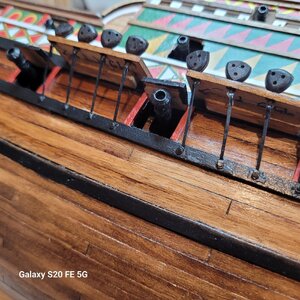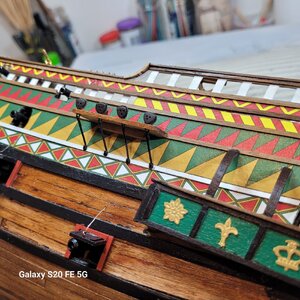You are using an out of date browser. It may not display this or other websites correctly.
You should upgrade or use an alternative browser.
You should upgrade or use an alternative browser.
HMS Revenge 1577 by Amati , Victory Models
- Thread starter mallacoota
- Start date
- Watchers 17
-
- Tags
- amati revenge victory models
The very fine workmanship is quite evident in your model. One comment meant just as an FYI for the future, English ships did not use belaying pins until well into the 18th century. Pins were used on Wasa and are known to have been around for a long time, so were there exceptions -- probably. The first use of pins on English ships had them on racks tied to the shrouds rather than on the bulwarks. There are some good drawings of belaying points of early 18th century ships in James Lees' The Masting and Rigging English Ships of War including Medway (60) 1742 and there are cleats and kevels, rails, and timber heads, but no pin racks and pins. The pictures below of a 60 from 1705 at Preble Hall show the use of rails, cross pieces, cleats, and timberheads.
Allan
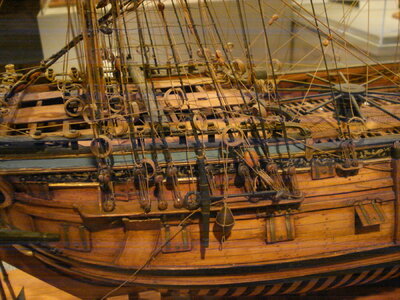
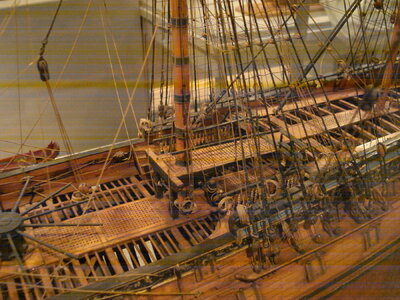
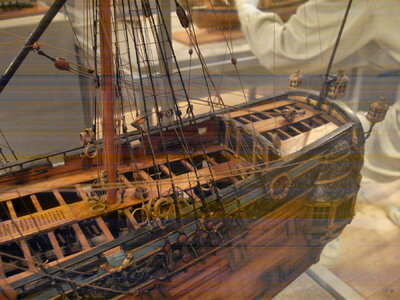
Allan



Interesting... just like the widespread misguided use of white bottoms on models of pre 1780-90 ships. You would have thought Chris Watton and Amati would have known that about the belaying pins because they feature prominently in the kit.The very fine workmanship is quite evident in your model. One comment meant just as an FYI for the future, English ships did not use belaying pins until well into the 18th century. Pins were used on Wasa and are known to have been around for a long time, so were there exceptions -- probably. The first use of pins on English ships had them on racks tied to the shrouds rather than on the bulwarks. There are some good drawings of belaying points of early 18th century ships in James Lees' The Masting and Rigging English Ships of War including Medway (60) 1742 and there are cleats and kevels, rails, and timber heads, but no pin racks and pins. The pictures below of a 60 from 1705 at Preble Hall show the use of rails, cross pieces, cleats, and timberheads.
Allan
View attachment 448980View attachment 448981View attachment 448982
My model of HMS Sovereign of the Seas c. 1635 has a white stuff bottom... Are you saying that is incorrect? I have this painting, you see, for reference. . .Interesting... just like the widespread misguided use of white bottoms on models of pre 1780-90 ships. You would have thought Chris Watton and Amati would have known that about the belaying pins because they feature prominently in the kit.
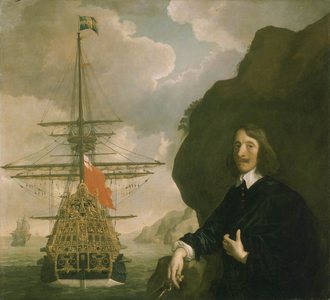
Yup! Looks white to me. . . . . . . . . . . . .
As for belaying pin racks on early ships, we have no evidence for or against their use prior to 1630 or thereabouts on English ships. I've always thought that model kit companies just guessed about their use for early ships. As for the Sovereign, I heard there is evidence specific to that vessel that pic racks were not used. The belaying pin controversy goes on in the absence of information.
Last edited:
Well I am not in a position to say that is wrong. My understanding of the use of white lead comes from Cook's 1770 journals. The Endeavour was coated with brown stuff...horsehair, pitch and whatever else...(but the modern replica is painted white below) as were 4 of his 5 ships boats. The Caldercraft kit photos is also white bottomed. The fifth ship's boat was coated with white lead as an experiment by the Admiralty against Toredo worm. When Cook got to the South Pacific the four "normal" ships boats were riddled with worm and the one with the expensive white lead was untouched. Cook reported this back in 1771 and after that the Admiralty started white leading their hulls when it was affordable. This must have only lasted about 100 yrs (dont know exactly) until copper plating became a better option. So whenever I see a pre 1770 ship with a white bottom I think the kit manufacturer ( including Amati with Mary Rose and Revenge) has more of an eye on the kit's market appeal than on historical accuracy.
That's my understanding of how white lead painting was introduced but I am very happy to be set straight by someone who has a better grasp of the history.
...and there will be plenty of them
John
That's my understanding of how white lead painting was introduced but I am very happy to be set straight by someone who has a better grasp of the history.
...and there will be plenty of them
John
Although we can make generalities about the use of white stuff, brown stuff, or black stuff on a particular ship's bottom, one has to remember that there are no fixed rules, and if you have documentary evidence that a particular ship had a certain bottom, you should go with that. In the absence of any specific day, your best guess is to go with what other ships probably had at the time.Well I am not in a position to say that is wrong. My understanding of the use of white lead comes from Cook's 1770 journals. The Endeavour was coated with brown stuff...horsehair, pitch and whatever else...(but the modern replica is painted white below) as were 4 of his 5 ships boats. The Caldercraft kit photos is also white bottomed. The fifth ship's boat was coated with white lead as an experiment by the Admiralty against Toredo worm. When Cook got to the South Pacific the four "normal" ships boats were riddled with worm and the one with the expensive white lead was untouched. Cook reported this back in 1771 and after that the Admiralty started white leading their hulls when it was affordable. This must have only lasted about 100 yrs (dont know exactly) until copper plating became a better option. So whenever I see a pre 1770 ship with a white bottom I think the kit manufacturer ( including Amati with Mary Rose and Revenge) has more of an eye on the kit's market appeal than on historical accuracy.
That's my understanding of how white lead painting was introduced but I am very happy to be set straight by someone who has a better grasp of the history.
...and there will be plenty of them
John
BTW...great painting...is thast Charles 1 with dividers pretending to be the architect or is it the architect..? Stll got his head on so could be either..??
Totally agree KurtAlthough we can make generalities about the use of white stuff, brown stuff, or black stuff on a particular ship's bottom, one has to remember that there are no fixed rules, and if you have documentary evidence that a particular ship had a certain bottom, you should go with that. In the absence of any specific day, your best guess is to go with what other ships probably had at the time.
If you had to guess, based on what you've learned, what color would be the best guess for the Revenge of 1577?Totally agree Kurt
if you open this link it takes you to the Royal Museum Greenwich model of Sovereign of ther Seas 1637
well guess is all I have done and I have just gone with brown...a little darker than topsides as a nod to it being "brown stuff" with pitch in it but I really havent highlighted the bottom to be honestIf you had to guess, based on what you've learned, what color would be the best guess for the Revenge of 1577?
Here's a thought.. if brown stuff was used, perhaps the model could be stained dark walnut brown below the waterline. That would allow the wood texture and some of the grain to stand out. One of the issues with doing this is coming up with a way to prevent the edge of the dark stained area from bleeding into the lighter stained wood above so as to preserve a sharp waterline between the two colors. Another thing to figure out is what color brown stuff really is. Perhaps mixing some real brown stuff and seeing what the color is? There's some model ship research for you. Instead of stain, I have lots of pine tar left over from staining sails on my last model, and maybe that could be cut with mineral spirits to become a stain that not only looks authentic but smells authentic too!well guess is all I have done and I have just gone with brown...a little darker than topsides as a nod to it being "brown stuff" with pitch in it but I really havent highlighted the bottom to be honest
Its a good thought and exactly what I did on my Endeavour. I just made a dirty dark brown below with Oak above the waterline and the result was good. Probably should have done that with Revenge but didnt think of it...dummy..!Here's a thought.. if brown stuff was used, perhaps the model could be stained dark walnut brown below the waterline. That would allow the wood texture and some of the grain to stand out. One of the issues with doing this is coming up with a way to prevent the edge of the dark stained area from bleeding into the lighter stained wood above so as to preserve a sharp waterline between the two colors. Another thing to figure out is what color brown stuff really is. Perhaps mixing some real brown stuff and seeing what the color is? There's some model ship research for you. Instead of stain, I have lots of pine tar left over from staining sails on my last model, and maybe that could be cut with mineral spirits to become a stain that not only looks authentic but smells authentic too!
Your gun belt is not properly installed, the trousers should be attached to the wing of the gun, and not to the ring at the back of the carriage.Installed the deck cannon. Also matched and prepared the channels. Placed full scale blue tape strips where the channels have to go so I could check out the cannon positions vs shrouds to avoid the conflict I had with Mary Rose. They fit well , and as I have said before this is a much better kit.
View attachment 447363View attachment 447364View attachment 447365
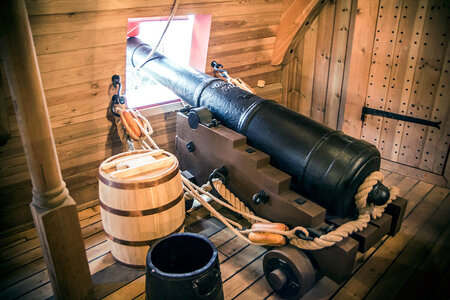
I am sure it is just a translation issue but I THINK what Winter is saying is that the breech rope should be attached to the cascabel as in the photo. In the case of Blomefields when they came into use about 1792, the breech rope went through a breech ring.
Finished the construction part of the four masts which was all quite straightforward. Now for the partial painting, fitting out of eyebolts and attached blocks. Would have done that before asembly but the painting reuirements made me decide to do it this way. Also need to fit futtock shrouds after painting to th mast tops. Obviously the masts are just standing in place for the photo.
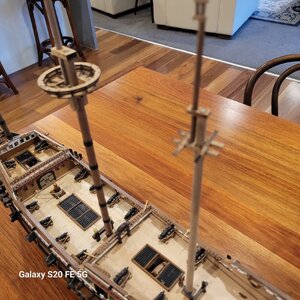
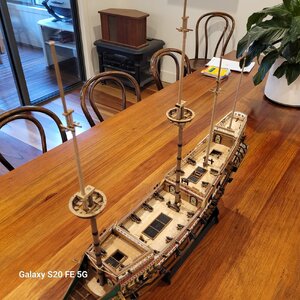
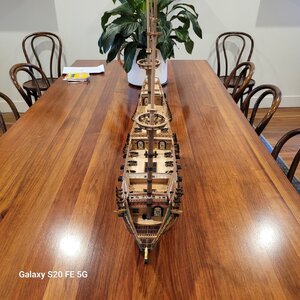



Last edited:
Nice! I see you modified slightly the lower portion of the upper Masts (square junction). Opps, I just checked mine and the plan... it was the design. I just forgot about it.
I was wondering about the capstan too... that new. Very interesting.
I was wondering about the capstan too... that new. Very interesting.
Last edited:
I wasnt sure wht you meant about the second mast sections as I thought I had done it as per plans.... but i maybe got it wrong. As for the capstan that was just a bit of silly kit bashing by me.... dont ask me to explain exactly what it is supposd to be doing..?Nice! I see you modified slightly the lower portion of the upper Masts (square junction). Opps, I just checked mine and the plan... it was the design. I just forgot about it.
I was wondering about the capstan too... that new. Very interesting.
John


